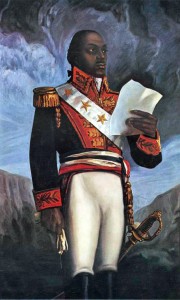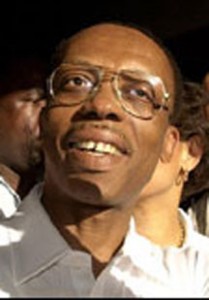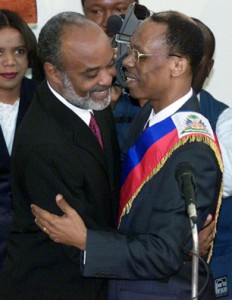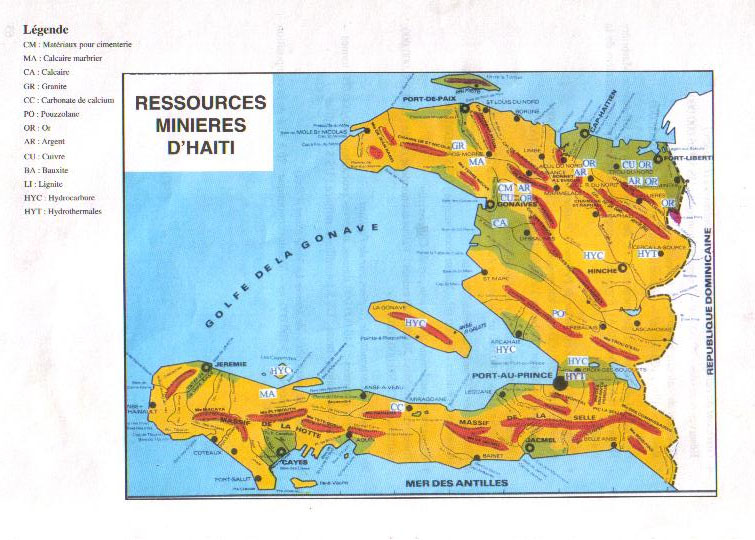by Timothy Alexander Guzman, Global Research, December 27, 2012
A former French colony called Saint-Domingue in the Western side of the Spanish Island of Hispaniola erupted into a Slave revolt against France. The revolt cost the lives of over 100,000 blacks and over 20,000 whites not including innocent civilians caught in the crosshairs of the revolution. The new Haitian Republic was born and won its independence from France in 1804. It became a free Republic that abolished slavery and became a center of inspiration for many African slaves across the world.
 But since the Haitian Revolution and it’s resistance to slavery, Western nations has managed to keep Haiti enslaved. From Internal conflicts that divided Haiti to successive dictatorships and a constant fear against a French invasion in the decades that followed, Haiti has always experienced a struggle for freedom. When President Theodore Roosevelt introduced “The Roosevelt Corollary” in a 1904 address to the US congress in relation to the Monroe Doctrine, he mentioned the fact that the US will intervene on the side of Europe who was in constant war against their former colonial possessions in Latin America if any new conflict were to arise from that point on. In 1915, the US Marines lead by Major General Smedley Butler, occupied Haiti under the orders of US President Woodrow Wilson to protect US Corporations and to prevent a people’s revolution. The occupation lasted until 1934. Then after the US occupation ended, Haitians chose a national assembly and elected Sténio Joseph Vincent as President of Haiti with US approval turned out to be an Authoritarian President.
But since the Haitian Revolution and it’s resistance to slavery, Western nations has managed to keep Haiti enslaved. From Internal conflicts that divided Haiti to successive dictatorships and a constant fear against a French invasion in the decades that followed, Haiti has always experienced a struggle for freedom. When President Theodore Roosevelt introduced “The Roosevelt Corollary” in a 1904 address to the US congress in relation to the Monroe Doctrine, he mentioned the fact that the US will intervene on the side of Europe who was in constant war against their former colonial possessions in Latin America if any new conflict were to arise from that point on. In 1915, the US Marines lead by Major General Smedley Butler, occupied Haiti under the orders of US President Woodrow Wilson to protect US Corporations and to prevent a people’s revolution. The occupation lasted until 1934. Then after the US occupation ended, Haitians chose a national assembly and elected Sténio Joseph Vincent as President of Haiti with US approval turned out to be an Authoritarian President.
And of course, the United States was its’ number one trading partner. Then followed President Élie Lescot who was ousted in a 1950 Coup by Army General Paul Eugene Magloire, another US approved presidency since he was anti-Communist. In 1957 Francois “Papa Doc” Duvalier became President-For-Life, of course with US approval until 1971. Then his son Jean Claude “Baby Doc” Duvalier became his successor until a popular revolt of the Haitian people in 1986 removed him from power. Under the Duvalier Dynasty, over 60,000 Haitians were killed and tortured by the Tonton Macoutes, a death squad created by “Papa Doc” who routinely used machetes and guns to murder his political opponents and anyone who spoke negatively against his regime. Many people were burned alive and hung in public. Top Members of the Tonton Macoutes were leaders of Voodoo which did earn them unlimited authority and the respect of the Haitian people. After Jean-Claude “Baby Doc” Duvalier was removed from power, the Tonton Macoutes were still active in other death squads for years to come, many eventually ended up in the Front for the Advancement and Progress of Haïti (FRAPH), A creation of the Central Intelligence Agency (CIA). Haiti’s relationship with the United States, France and Canada in the past decades is a contributing factor to the Haitian government’s failed political and economic policies that has had a negative impact on its people.
 Then Jean-Bertrand Aristide came on the national stage. An educated former priest who was born into poverty, managed to inspire the people to participate in building a new democracy in Haiti. Aristide’s influence among the Haitian people concerned Western nations especially the United States. It was also a concern for the Haitian elites. As a Priest, Aristide began to recruit youths to attend church, so he organized weekly youth masses. He founded an orphanage for urban street children in 1986 called “Lafanmi Selavi” or “Family is Life”, a program that was a model of participatory democracy for children who participated. Aristide became a leading voice for Haiti’s poor majority, but he became a target for assassination as they attempted to murder him on numerous occasions. Aristide announced his candidacy for the presidency in 1990 and in a six-week campaign with his supporters formed a political party called the “Front National pour le Changement et la Démocratie” or the “National Front for Change and Democracy (FNCD). Aristide was successful and was elected President with 67% of the Haitian vote defeating US-approved candidate Marc Bazin, a former World Bank official. Haiti’s first Democratic president was elected by the people. Democracy was finally becoming a reality, but the United States and its’ Western Allies were not keen on the new President’s policies concerning his politics of change, economics or his war on drugs. His ideas for Democratic change enabled him to become a leading figure among the Haitian people. This was clearly not in Washington’s best interest.
Then Jean-Bertrand Aristide came on the national stage. An educated former priest who was born into poverty, managed to inspire the people to participate in building a new democracy in Haiti. Aristide’s influence among the Haitian people concerned Western nations especially the United States. It was also a concern for the Haitian elites. As a Priest, Aristide began to recruit youths to attend church, so he organized weekly youth masses. He founded an orphanage for urban street children in 1986 called “Lafanmi Selavi” or “Family is Life”, a program that was a model of participatory democracy for children who participated. Aristide became a leading voice for Haiti’s poor majority, but he became a target for assassination as they attempted to murder him on numerous occasions. Aristide announced his candidacy for the presidency in 1990 and in a six-week campaign with his supporters formed a political party called the “Front National pour le Changement et la Démocratie” or the “National Front for Change and Democracy (FNCD). Aristide was successful and was elected President with 67% of the Haitian vote defeating US-approved candidate Marc Bazin, a former World Bank official. Haiti’s first Democratic president was elected by the people. Democracy was finally becoming a reality, but the United States and its’ Western Allies were not keen on the new President’s policies concerning his politics of change, economics or his war on drugs. His ideas for Democratic change enabled him to become a leading figure among the Haitian people. This was clearly not in Washington’s best interest.
On September 29th, 1991 a Coup d’état took place under then US President George H.W. Bush that toppled Aristide by Army General Raoul Cédras, Army Chief of Staff Phillipe Biamby and Chief of the National Police Michel François with support from the CIA. He was replaced by Superior Court Justice Joseph Nérette for a short period of time until a new president took place with US approval. The coup was condemned by the UN General Assembly (UNGA) and the Organization of American States (OAS) in October of that same year. The new Haitian regime that replaced Aristide was only recognized by the Vatican City where the head of the Roman Catholic Church “the Pope” exercises legislative, executive, and judicial powers. Vatican City believed that Aristide’s “incitement to hatred and violence” was not in line with the principles with the Catholic Church. Talk about “truth is stranger than fiction”. The irony is that Aristide was a former Catholic priest who was appointed to St. Jean Bosco church to help the poor. It was located in one of the poorest neighborhoods in Port-au-Prince. However, with Vatican City condemning Aristide’s actions gave Washington ‘Carte Blanche’ to proceed with the Coup d’état since the church Aristide was associated with condemned him.
But what was the main reason behind Aristide’s Coup in his short time in office? It was evident that his strong opposition to drug smuggling on Haiti’s territory was the main reason why he was forced out of public office. General Raoul Cédras and Police Chief Michel François, a graduate of U.S. Army’s School of the Americas (SOA) now called the Western Hemisphere Institute for Security Cooperation (WHINSEC) were accused of drug smuggling under CIA supervision. As reported by Dennis Bernstein of the Pacific News Service October 20th, 1993 that American Representative and Democrat John Conyers of Michigan was quoted as saying “I’ve been amazed that our government has never talked about the drug trafficking…even though it is obviously one of the major reasons why these people drove their president out of the country and why they are determined not to let him back in. We’re talking hundreds of millions of dollars of illegal profits that are having disastrous consequences for the American people”. Aristide’s anti-drug crusade put him at odds with the Washington, the Haitian Military, and the political and business elites who opposed his policies. In an interview conducted by WBAI, 99.5 FM Radio News Program in New York City with Patrick Elie, former head of Haiti’s Anti-Narcotics Unit discussed who was behind the September 30, 1991 coup d’état of Aristide:
You had the usual suspects – mainly the US administration through the CIA and of course part of the Haitian monied elite, which financed the coup and helped the military and the death-squads survive some of the sanctions that were applied by the OAS. The reason why I can affirm that the CIA was actually involved in the preparation of the coup is that, first of all, no coup ever takes place in Haiti without the blessing of the US – either the DIA or the CIA – but also at the time because of my position as the head of the Anti-Narcotics program. I had contact with the CIA station chief in Haiti and the questions he was posing to me regarding the security of the new government were the exact issues that were raised the very same day of the coup by the military that pulled that coup.
After President Aristide was removed from power, he was sent into exile; first he lived in Venezuela and then went on to the United States. Then under Emmanuel “Toto” Constant, a paid CIA informant who organized a death squad called the Front for the Advancement and Progress of Haiti (FRAPH) targeted Aristide’s supporters that resulted in the deaths of more than 4,000 people. The Haitian population was now officially under state terror since Aristide’s departure.
William Jefferson Clinton was elected President of the United States in 1993. He promised the return of Aristide with a plan to re-introduce neoliberal policies that Aristide opposed. Clinton also wanted to end the Haitian refugee crisis on Florida’s shores due to Haiti’s political crises. Under US and international pressure along with the United Nations Security Council Resolution 940 on July 31 1994, the military regime in power agreed to step-down as US troops were deployed to Haiti under Clinton’s order. So on October 15th, 1994, the Clinton administration permitted Aristide to return to Haiti to complete his term in office, but under the conditions that he adapt the economic program of the World Bank and the International Monetary Fund (IMF) of the defeated US backed candidate Marc Savin from the 1990 elections. Aristide had to accept the terms and returned to Haiti with 20,000 US troops on stand-by for the transition. American style “Democracy” was back in Haitian politics. The World Bank and the IMF are the same institutions responsible for impoverishing many nations in the Third World and now were responsible for the Neoliberal economic policies that eventually destroyed Haiti’s economic sovereignty. Aristide remained in power until 1996. Then René Préval was elected president for a 5-year term, winning 88% of the popular vote. Préval was Aristide’s Prime Minister for several months until the 1991 US-instigated military Coup.
 Aristide was re-elected in 2000 and resumed his Presidency in 2001. Then in February 2004, the United States and France once again removed Aristide from power and flew him out of the country because he refused to “Privatize” State Owned Enterprises that included Electricity for private run “Monopolies”. The Privatization of State owned enterprises would squeeze the poor even further into paying higher prices for their basic utilities. The US used the assassination of gang leader named Amiot Metayer to destabilize Aristide’s government as it caused anti-government groups to turn against Aristide. The National Revolutionary Front for the Liberation of Haiti was formed under Amiot’s brother, Buteur Metayer, who accused Aristide for his brother’s murder. The rebels took control of the North and eventually invaded the capital of Port-au -Prince. The U.S. escorted Aristide out of the country on February 28, 2004 and sent him to the Central African Republic then to South Africa. Aristide’s lawyer had claimed that the U.S. was arming anti-Aristide groups before the assassination of Metayer and that France and the US had “kidnapped” Aristide. Another staged Coup against Aristide, this time under US President George W. Bush. Aristide was exiled to South Africa.
Aristide was re-elected in 2000 and resumed his Presidency in 2001. Then in February 2004, the United States and France once again removed Aristide from power and flew him out of the country because he refused to “Privatize” State Owned Enterprises that included Electricity for private run “Monopolies”. The Privatization of State owned enterprises would squeeze the poor even further into paying higher prices for their basic utilities. The US used the assassination of gang leader named Amiot Metayer to destabilize Aristide’s government as it caused anti-government groups to turn against Aristide. The National Revolutionary Front for the Liberation of Haiti was formed under Amiot’s brother, Buteur Metayer, who accused Aristide for his brother’s murder. The rebels took control of the North and eventually invaded the capital of Port-au -Prince. The U.S. escorted Aristide out of the country on February 28, 2004 and sent him to the Central African Republic then to South Africa. Aristide’s lawyer had claimed that the U.S. was arming anti-Aristide groups before the assassination of Metayer and that France and the US had “kidnapped” Aristide. Another staged Coup against Aristide, this time under US President George W. Bush. Aristide was exiled to South Africa.
The United Nations Security Council Resolution 1542 was established on April 30th, 2004 due to Haiti’s instability in the region that would allow peacekeepers on Haitian territory. The purpose of the mission was to train the Haitian National Police Force and provide peace and security to the Haitian population. Since June 1st, 2004, the United Nations Stabilisation Mission In Haiti (UNSTAMIH) better known as MINUSTAH led by the Brazilian Military has been a disaster for Haitians.Since their arrival, Haiti has experienced human rights violations under the banner of stabilization, but rather has been a destabilizing force under MINUSTAH. MINUSTAH’s primary objective was to train the Haitian National Police Force, but had been implicated in numerous crimes, from the sexual assault of an 18-year-old Johnny Jean by Uruguayan peacekeepers caught on video to the sexual exploitation of minors including prostitution and rape that involved more than 100 Sri Lankan peacekeepers. The murder of a 16-year-old boy hung in a UN base in Cap Haïtien on August 2010 after he was accused of stealing $200 from a UN interpreter and the outbreak of Cholera in mid-2010 that killed over 6,000 Haitians and infected over 400,000 other’s that were exposed to the unsanitary practices by Nepalese peacekeepers on another UN base began a public outcry against the UN occupation of Haiti. MINUSTAH is also a political police force who executed Pro-Aristide groups in Cite Soleil on Dec 22, 2006, a slum in the capital of Port-au-Prince that killed more than 30 people including women and children. It was massacre against the community for their support of the Lavalas movement which involved more than 10,000 people who rallied for the return of President Aristide and called for an end to the UN military occupation of Haiti, but the United Nations claimed that they were out to capture or kill “Gangsters and Kidnappers”. On October 15, 2012 MINUSTAH’s mission has been extended to 2013. Then it will be extended to 2014. Maybe the UN occupation will become permanent? What is the real purpose of this military occupation? Is it to set up bases that the US and its’ allies would be able to use against their enemies such as Cuba, Ecuador or Venezuela? Haiti is in close proximity to Cuba and the northern cone of South America. There is also one element of Haiti that should not be overlooked, and that is the vast amount of natural resources Haiti has on its land. Haiti has bauxite, coal, copper, calcium carbonate, gold, gypsum, hydropower, marble, silver, tin, lignite, nickel, limestone, manganese, marble, iron, tungsten, salt, clay, building stones and most importantly oil. Oil had been discovered in Haiti. Haitian writer, Dr. Georges Michel, published an online article on March 27th, 2004 titled ‘Oil in Haiti.’ Dr. Georges Michel wrote:
It has been no secret that deep in the earthy bowels of the two states that share the island of Haiti and the surrounding waters that there are significant, still untapped deposits of oil. One knows not why they are still untapped. Since the early twentieth century, the physical and political map of the island of Haiti, erected in 1908 by Messrs. Alexander Poujol and Henry Thomasset, reported a major oil reservoir in Haiti near the source of the Rio Todo El Mondo, Tributary Right Artibonite River, better known today as the River Thomonde
One of the main reasons that the US, Canadian and European governments decide to send American and UN Peacekeeping forces is to undermine governments who oppose their policies and to exploit their natural resources for profit. In an October 2008 cable released by Wikileaks, U.S. Ambassador to Haiti Janet Sanderson said that “The security dividend the U.S. reaps from this hemispheric cooperation not only benefits the immediate Caribbean, but also is developing habits of security cooperation in the hemisphere that will serve our interests for years to come.”
Do US interests involve natural resources and a central military location to checkmate Cuba and other countries located in South America that are non-compliant? It is interesting to know that a crises whether a natural disaster such as the Haitian earthquake of January 12th, 2010 where an estimated 316,000 people had died, over 300,000 injured and left more than 1 million people homeless or a political situation that would involve regime change was used as an excuse to place UN Peacekeeping forces (MINUSTAH) in Haiti. It is the same organization that committed numerous crimes that will train the Haitian National Police Force as a tool to control and subjugate the Haitian population. Haiti has natural resources and a hard working population. They should not be the poorest nation in the Western Hemisphere. Haiti is enslaved again, but this time under Globalization, a system that is under the control of Western Imperial powers. After 221 years nothing has changed. Western Powers, both old and new control the political, social and economic landscape of Haiti. Michel “Sweet Mickey” Martelly is the new US approved President of Haiti since May of 2011.
He has resurrected the Haitian military with intelligence and security units with former military officers, members of the Police force and paramilitary death squads that were involved in Aristide’s Coup d’état in 2004. Reestablishing the Haitian military was a campaign promise he kept and will keep well into 2013 with a Duvalier-style government. With President Martelly in office until 2016 and the United Nations Stabilization Mission in Haiti (MINUSTAH) until October 15th, 2013, it seems that Haiti’s future will be marked with the same problems it has experienced since it gained independence back in 1804.

